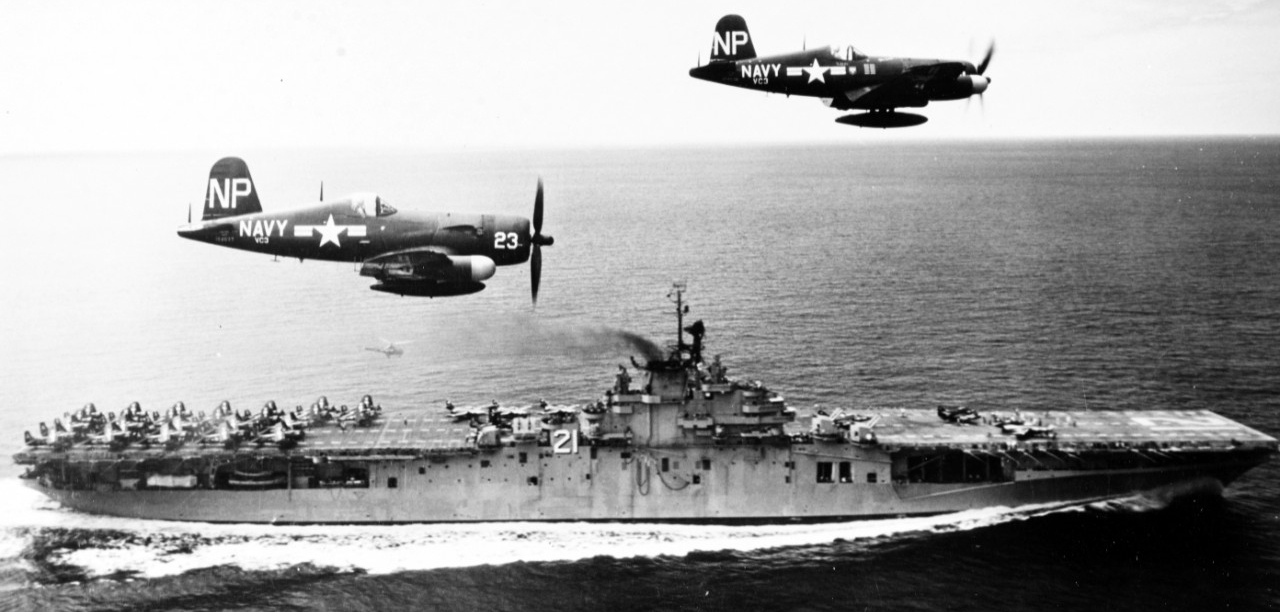Ships and Aircraft
USS Boxer (CV-21) with two F4U-5N Corsair fighters of squadron VC-3 fly past the carrier, during combat operations off Korea. Photo is dated 4 September 1951. These planes are Bureau #s 124537 (left) and 124539. Their pilots are LT John D. ELy, USNR, and LTJG J.G. Stranlund, USNR. Official U.S. Navy Photograph, now in the collections of the National Archives. (NHHC 80-G-433005)
On 25 June 1950, the ships in the Naval Forces Far East (NAVFE) consisted of "one cruiser, four destroyers, four amphibious ships, one submarine, ten minesweepers, and a frigate attached from the Australian navy."[1] Within the first 48 hours, the Seventh Fleet was assigned to NAVFE. Of the 15 foreign countries in the United Nations (UN) other than the United States and South Korea that participated in this conflict, eight of those countries sent more than 100 vessels to be assigned to the U.S. Command Far East. These vessels combined with NAVFE were organized into four separate task forces (TF): TF 77, the carrier strike force; TF 95, the blockade-and-escort force; TF 96, Naval Forces, Japan; and TF 90, the Far East Amphibious Force.
Their operations were a well-orchestrated coordinated effort that demonstrated the effectiveness of seaborne mobility of the U.S. Navy and its UN allies. Within the first month, they had accomplished their first objective of establishing control of the seas around Korea. Their neutralization of the enemy threat at sea allowed the commanders aboard the ships of the U.S. Navy to focus on support for land operations. Ships of the U.S. Navy served as platforms for coastal operations including the invasion at Inchon and the evacuation from Hungnam.
Aircraft from carriers supported to land operations and destroyed inland targets in an effort to disrupt enemy supply and communication lines. Battleships, cruisers, and destroyers formed a “bombline” firing on inland targets in support of combat operations. Along the coast, minesweepers worked to clear shipping lanes and harbors for coastal and amphibious operations. Each vessel in the U.S. Navy assigned the waters around Korea had a role in service of the troops serving onshore and offshore.
***
[1] U. S. Navy Special Operations in the Korean War, https://www.history.navy.mil/content/history/nhhc/research/library/online-reading-room/title-list-alphabetically/u/usnavy-special-operations-korean-war.html (accessed 19 Jan 2020).
Ships
- Korean War U.S. Pacific Fleet Operations Interim Evaluation Report
- U.S. Navy Active Ship Force Levels, 1951-1957
- Ships Sunk and Damaged in Action
- Essay on Naval Battles of the Korean War, By Edward J. Marolda
Subject Index by Ship Type or Fleet
The Seventh Fleet
- Ready Seapower: A History of the US Seventh Fleet, by Edward J. Marolda
Minesweepers
Aviation
- Communities – Naval Aviation – 1950-53
- Korean War: Chronology of U.S. Pacific Fleet Operations, January–June 1951
- Naval Aviation's Involvement in the Korean War
- Naval Aviation 1910–2010
- Volume 1, Chapter 7, The Korean War 1950–1953 [PDF]
- Dictionary of American Naval Aviation Squadrons, Volume II:
History of VP, VPB, VP(H) and VP(AM) Squadrons - List of Patrol Squadron Deployments to Korea during the War
- Korean War Combat Action Reports for Carrier Air Groups
- USN and USMC Tactical Aircraft Operating in the Korean Theater During the Korean Conflict
Special Topics
- History Up Close: The U.S. Navy’s “Dambusters” at Hwachon Dam
- Len Plog and the Real Yak Killer, by Jim Burridge. Naval Aviation News May–June 1997
- No “Half-Ready Militia”: Rear Admiral Austin K. Doyle, the Naval Air Reserve, and the Lessons of Preparing for War by Hill Goodspeed, submission from the 2017 CNO Naval History Essay Contest



